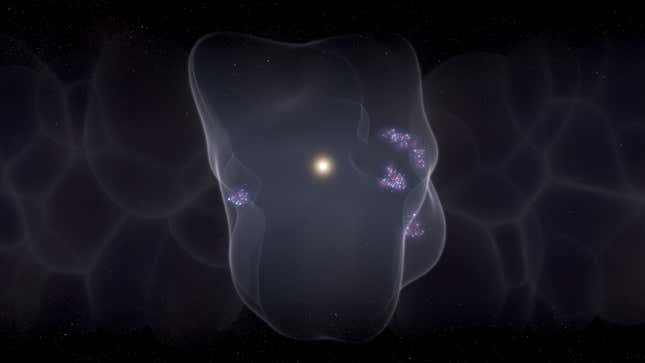
A team of astronomers has reconstructed the history of our local universe to understand the origin of the nearest stars. In a study published today in Nature, they describe an amorphous, 1,000-light-year-wide bubble ensconcing Earth that is responsible for those stars.
Called the Local Bubble, the researchers believe it formed from a series of large explosions that blasted energy into space over the last 14 million years. Those explosions were supernovae—spectacular collapses of stars that sometimes leave behind beautiful nebulae. In this case, the supernovae also shaped our galactic neighborhood, 500 light-years in any direction from Earth.
“We find that all nearby, young stars formed as powerful supernova explosions triggered an expanding shockwave, sweeping up interstellar clouds of gas and dust into a cold dense shell that now forms the surface of the Local Bubble,” said study co-author Catherine Zucker in an email to Gizmodo.
“Astronomers have theorized for many decades that supernovae can ‘sweep up’ gas into dense clouds that ultimately form new stars, but our work provides the strongest observational evidence to date in support of this theory,” added Zucker, an astronomer at the Center for Astrophysics | Harvard & Smithsonian.
The team modeled how the explosions likely took place over millions of years, pushing gas outward like a broom sweeping up dust. At its genesis, the bubble was probably moving outward at about 60 miles per second, Zucker said. It’s still expanding today, but at a more leisurely 4 miles per second. Interactive figures of the bubble can be seen here.
Our Solar System is at the center of the bubble, rather than at its edge. That’s because, unlike the stars on the Local Bubble’s periphery, our solar system was born much longer ago than the last 14 million years.

“When the Local Bubble first started forming, the Earth was over 1,000 light-years away,” Zucker said. “We think the Earth entered the bubble about 5 million years ago, which is consistent with estimates of radioactive iron isotope deposits from supernova in the Earth’s crust from other studies.”
The Local Bubble is a lot like the Per-Tau shell, a cavity in space between the constellations Perseus and Taurus. The Per-Tau shell has large gas clouds, called molecular clouds, on either side of it, and researchers believe the shell is what remains of supernovae that pushed the gas outward. The recent team believe the Local Bubble has a similar origin, but as it is 10 times larger, probably required a bit more firepower to get going (approximately 15 supernovae).
“It seems as the two bubbles interact on their edges, where the Taurus molecular cloud is located,” said study lead author Shmuel Bialy, a theoretical astrophysicist at the Center for Astrophysics | Harvard & Smithsonian, in an email to Gizmodo. “The interaction of the two bubbles may potentially be the cause for the formation of Taurus. This however requires a further investigation.”
These sorts of bubbles were theorized decades ago, but modern techniques are able to test those theories in ways that weren’t previously possible. The researchers also note that it’s likely the Milky Way is chock-full of these bubbles, as, if they were rare, it’d be unlikely our solar system would just happen to be right at the center of one.
Deciphering how the bubbles interact with each other is the next step for understanding how these structures act as nurseries for stars throughout the galaxy. And with our planet at the center of one, we’re in a great position to learn more.
More: Astronomers Find Massive Space ‘Cavity’ Possibly Left Behind by Explosion